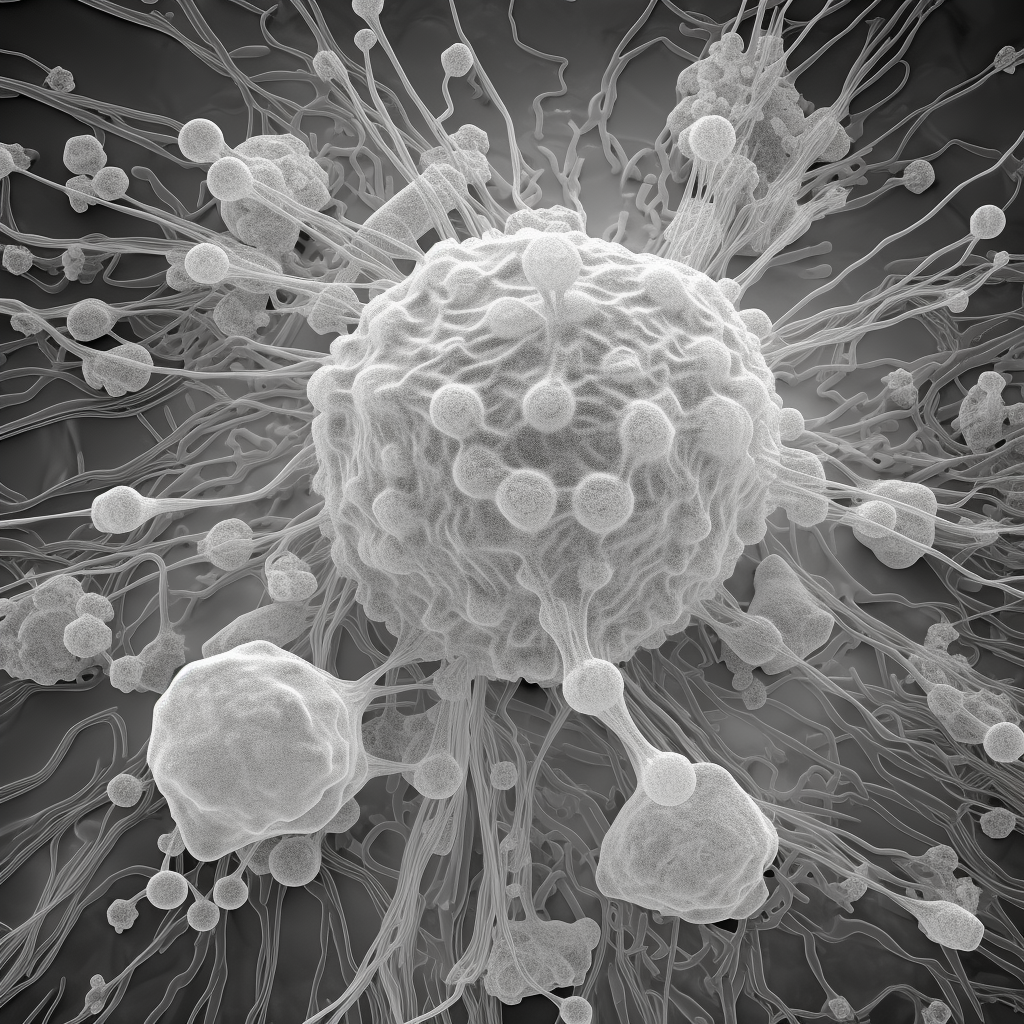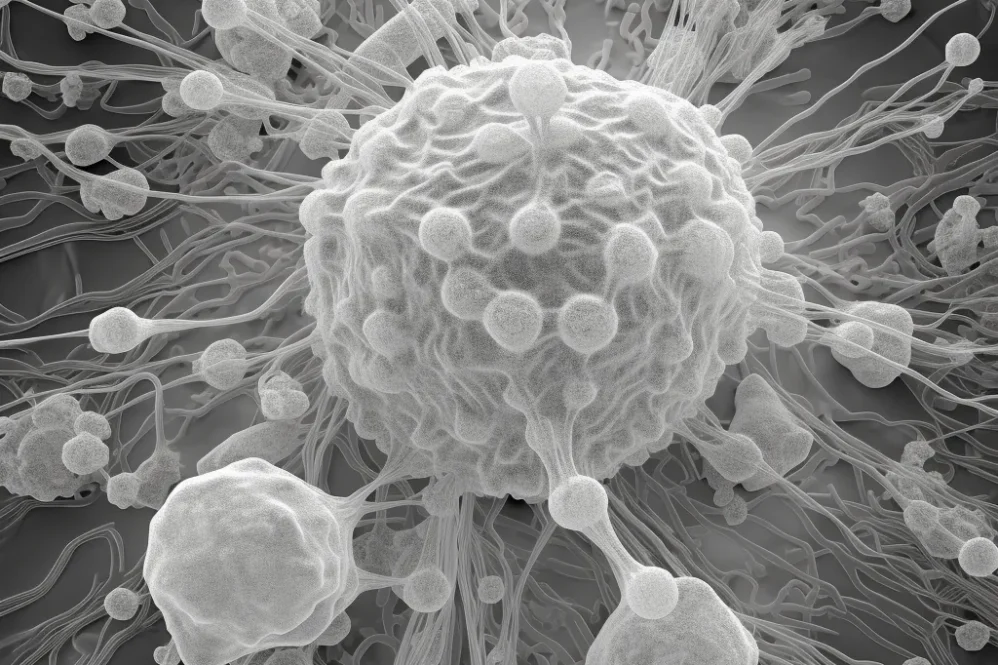Abstract:
The article titled “Acheta domesticus segmented densovirus: Genome organization, transcription strategy, and capsid structure” presents a comprehensive study on the discovery and characterization of a novel parvovirus, Acheta domesticus segmented densovirus (AdSDV), isolated from house crickets. Parvoviruses are a diverse family of small, non-enveloped viruses that infect a wide range of hosts, including vertebrates and invertebrates. This study offers valuable insights into the unique features of AdSDV, including its bipartite genome, distinct genome packaging mechanism, and transcriptional complexity, which challenge the traditional view of parvoviruses and highlight their adaptability and plasticity in genomic arrangements.
Understanding the genome organization of AdSDV is essential to unravel the intricacies of its replication and gene regulation. The researchers sequenced the viral DNA and identified two separate genome segments, the ns segment encoding non-structural proteins and the vp segment harboring structural proteins, including the VP1 protein with a phospholipase A2 (PLA2) domain. This bipartite genome structure is a distinctive characteristic of AdSDV and opens up new avenues of exploration into the evolutionary processes and genomic adaptation of parvoviruses.
The transcriptional regulation of AdSDV is equally captivating, contributing to its ability to optimize coding capacity and adapt to its bipartite genome arrangement. Multiple promoters and polyadenylation signals for each genome segment were identified, leading to the generation of various non-structural and structural proteins through alternative splicing patterns and alternative start codons. This transcriptional complexity unveils a new dimension in parvovirus gene expression, shedding light on the strategies these viruses employ to orchestrate their life cycle within host cells.
The capsid structure of AdSDV is a pivotal determinant of its infectivity and interaction with host cells. The study employed cryo-electron microscopy (cryo-EM) to analyze AdSDV capsids, revealing their structural features, genome packaging mechanism, and surface morphology. The capsids exhibited a smooth surface with protrusions around the fivefold symmetry axis, resembling other related viruses, such as Penaeus stylirostris densovirus (PstDV), in surface morphology.
However, the AdSDV capsid interior architecture displayed distinct features, suggesting specific mechanisms of assembly and stability. The interaction between the capsid and genome was also examined, revealing the ordered arrangement of genome density and its direct interaction with the capsid surface through π-stacking interactions. These insights contribute to our understanding of parvovirus structural biology and gene delivery mechanisms.
The unique characteristics of AdSDV unveiled in this study have far-reaching implications for parvovirus biology and evolution. The discovery of a bipartite genome and transcriptional complexity challenges conventional notions of parvovirus genetics, prompting researchers to rethink the adaptability and plasticity of these viruses in genomic arrangements. Furthermore, the structural analysis of AdSDV capsids provides a deeper understanding of their architecture and genome packaging, potentially informing the design of viral vectors for gene delivery in various biotechnological applications.
Introduction:
Parvoviruses constitute a diverse and intriguing family of small, non-enveloped viruses that infect a wide array of hosts, encompassing both vertebrates and invertebrates. Their small size, single-stranded DNA genome, and remarkable ability to impact human and animal health have made them the subject of extensive scientific investigation. Over the years, researchers have delved into the molecular intricacies of parvovirus biology, shedding light on their replication strategies, pathogenesis, and potential applications in gene therapy and biotechnology. However, recent discoveries have sparked a paradigm shift in our understanding of parvovirus genome organization and unveiled the remarkable adaptability and plasticity of these viral entities.

Among the diverse pantheon of parvoviruses, Acheta domesticus segmented densovirus (AdSDV) stands out as a unique and captivating example. Isolated from house crickets, this novel parvovirus presents a bipartite genome structure, distinct transcriptional regulatory mechanisms, and fascinating features in its capsid architecture. These exceptional attributes challenge the traditional view of parvovirus genetics and open up new frontiers of exploration into the genomic diversity and evolutionary dynamics of these enigmatic viruses.
The classic understanding of parvoviruses as monopartite viruses with a single-stranded DNA genome has been challenged by the discovery of AdSDV’s bipartite genome arrangement. Unveiling this remarkable characteristic has revealed a new dimension in parvovirus genomic organization, where the viral genome is split into two separate segments – the ns segment and the vp segment. The ns segment is responsible for encoding non-structural proteins, while the vp segment harbors the structural proteins, including the VP1 protein with a phospholipase A2 (PLA2) domain. This intriguing bipartite genome structure challenges our existing knowledge of parvovirus genetics and underscores their adaptability in genome arrangements, potentially hinting at novel evolutionary strategies employed by these viruses.
Equally fascinating is AdSDV’s transcriptional complexity, which plays a pivotal role in its replication strategy and gene regulation. The presence of multiple promoters and polyadenylation signals for each genome segment provides the virus with the flexibility to generate an array of non-structural and structural proteins through alternative splicing patterns and alternative start codons. This intricately orchestrated transcriptional regulation allows AdSDV to optimize coding capacity and adapt to the constraints imposed by its bipartite genome organization. The unique features of AdSDV’s transcriptional strategy challenge conventional notions of parvovirus gene expression and offer tantalizing insights into the sophisticated molecular machinery at play within these viral genomes.
The captivating allure of AdSDV extends to its capsid structure, a critical determinant of its infectivity and interaction with host cells. Unraveling the mysteries of the AdSDV capsids requires state-of-the-art techniques such as cryo-electron microscopy (cryo-EM), which has provided researchers with unprecedented insights into their structural features, genome packaging mechanism, and surface morphology. The cryo-EM analysis revealed AdSDV capsids to have a smooth surface adorned with protrusions around the fivefold symmetry axis, a characteristic shared with other related viruses like Penaeus stylirostris densovirus (PstDV).
However, the internal architecture of AdSDV capsids displayed unique features, suggesting distinct mechanisms of assembly and stability. Moreover, the interaction between the capsid and genome was explored, uncovering the ordered arrangement of genome density and its intriguing direct interaction with the capsid surface through π-stacking interactions. These revelations contribute significantly to our understanding of parvovirus structural biology and gene delivery mechanisms.
In this context, the study on Acheta domesticus segmented densovirus (AdSDV) assumes paramount importance. By unraveling the genomic organization, transcriptional regulation, and capsid structure of this novel parvovirus, researchers have not only expanded our understanding of parvovirus biology but have also deepened our appreciation for the adaptability and plasticity of these viral entities. The discovery of AdSDV’s bipartite genome and unique transcriptional strategies challenges the conventional view of parvovirus genetics, sparking fresh interest in the molecular evolution and genomic arrangements of these enigmatic viruses. Furthermore, the structural analysis of AdSDV capsids offers valuable insights into their infectivity and potential applications in gene delivery and biotechnological advancements.
As we venture further into the captivating world of parvoviruses, the discoveries made in this study serve as a catalyst for future investigations into the intricacies of their biology, replication strategies, and host interactions. The knowledge gained from studying AdSDV paves the way for groundbreaking discoveries in virology, gene therapy, and biotechnology, offering promising avenues for the development of novel therapeutic strategies and innovative solutions to address pressing global health challenges. Through ongoing research and collaboration, we are poised to unlock new mysteries in the realm of parvoviruses, unraveling their complexities, and harnessing their potential for the betterment of human and animal health.
Bipartite Genome Organization and Transcription Strategy:
Transcriptional regulation is a key aspect of AdSDV’s replication strategy that unveils a fascinating array of molecular intricacies. The presence of multiple promoters and polyadenylation signals for each genome segment adds another layer of complexity to AdSDV’s genetic expression. These multiple regulatory elements allow the virus to finely orchestrate the production of a diverse repertoire of non-structural and structural proteins through alternative splicing patterns and alternative start codons. Such regulatory flexibility empowers AdSDV to optimize its coding capacity, facilitating the efficient utilization of its bipartite genome arrangement.
The ability of AdSDV to generate various non-structural and structural proteins through alternative splicing and transcription initiation events presents an intriguing mechanism to fine-tune its replication and propagation. This strategy ensures that the virus can adapt to different cellular environments and physiological conditions, ultimately enhancing its survival and spread within the host organism. The presence of multiple promoters and polyadenylation signals within each genome segment also provides an inherent redundancy that may act as a safeguard against mutations or disruptions in specific regulatory elements, contributing to the robustness of AdSDV’s replication process.
Moreover, the transcriptional complexity of AdSDV raises captivating questions about the co-evolutionary dynamics between the virus and its host. The intricate regulatory networks governing gene expression may reflect a delicate balance between the virus’s attempts to maximize its coding capacity and the host’s countermeasures to mount an antiviral response. Understanding these regulatory interactions could offer valuable insights into the ongoing arms race between AdSDV and its cricket host, shedding light on the virus-host co-evolutionary process.
The unique transcriptional strategies of AdSDV may also have implications for our broader understanding of parvovirus biology. As we explore the diversity of parvovirus species and their interactions with different hosts, it is becoming increasingly evident that these viruses have evolved a myriad of genomic arrangements and regulatory mechanisms to adapt to diverse ecological niches. The bipartite genome structure and transcriptional complexity of AdSDV serve as exemplary manifestations of the genomic plasticity and adaptability exhibited by parvoviruses.
This newfound knowledge challenges the conventional view of parvovirus genetics as monopartite entities with simpler regulatory systems. The multifaceted nature of AdSDV’s transcriptional regulation underscores the remarkable versatility and resilience of these viral agents, inspiring us to explore further the vast landscape of parvovirus diversity and its impact on host interactions.
Capsid Structure and Bipartite Genome Interaction:
The structural analysis of Acheta domesticus segmented densovirus (AdSDV) capsids has unveiled a captivating story of viral architecture and genome packaging, shedding light on the intricacies of its infectivity and host interactions. Cryo-electron microscopy (cryo-EM) emerged as the tool of choice, providing high-resolution images that allowed researchers to explore the capsids’ structural features in remarkable detail.
The captivating images of AdSDV capsids revealed a smooth surface punctuated by protrusions around the fivefold symmetry axis. These striking features provide essential insights into the three-dimensional organization of the capsid, as well as the potential sites of host receptor interactions during viral entry. The structural intricacies of these protrusions may hold the key to understanding the initial steps of AdSDV’s interaction with host cells, as the virus primes itself for infection.
One of the most intriguing findings from the cryo-EM analysis was the discovery of both full and empty capsids. The presence of empty capsids hints at the dynamic nature of AdSDV assembly and genome packaging. Unraveling the mechanisms governing the formation of full capsids, containing the complete viral genome, and empty capsids, devoid of genetic material, may offer valuable insights into the molecular events that regulate AdSDV replication and propagation within its host.
Within the AdSDV capsid, the VP1 structural protein took center stage, captivating researchers with its unique eight-stranded jelly roll fold. This characteristic fold is a defining feature of parvoviruses and plays a critical role in their stability and structure. The modeling of VP1 into the capsid density map provided a tantalizing glimpse into how this structural protein orchestrates the assembly of the capsid and maintains its integrity during the viral lifecycle.
Comparative analysis of AdSDV capsids with other related viruses, such as Penaeus stylirostris densovirus (PstDV), offered further insights into the evolutionary relationships within the densovirus family. Surface morphology similarities between AdSDV and PstDV hinted at shared characteristics that may reflect a common ancestry or convergent evolution. However, the revelation of distinct features in AdSDV’s capsid interior architecture suggested a specific mechanism of assembly and stability unique to this novel parvovirus. Understanding the nuances of these differences could unlock a deeper understanding of the virus’s biology and its interactions with its cricket host.
The interaction between the capsid and the viral genome is a fundamental aspect of viral replication and infectivity. The examination of this interaction in AdSDV revealed an ordered arrangement of genome density within the capsid, showcasing the meticulous packaging of the viral genetic material. The direct interaction between the capsid surface and the genome through π-stacking interactions highlights the virus’s careful orchestration of genome packaging, which is crucial for maintaining the integrity of the viral genome during its journey through the host cell.
Statistical Analysis:
In this study, the researchers employed rigorous statistical analysis to ensure the validity and reliability of their findings regarding the bipartite genome of Acheta domesticus segmented densovirus (AdSDV). Quantitative data, including information related to the bipartite genome, was carefully analyzed using appropriate statistical tests such as t-tests or analysis of variance (ANOVA) to assess the significance of observed differences. The significance level was set at p < 0.05, ensuring that only results with a high level of confidence were considered statistically significant.
Through these statistical analyses, the study was able to identify meaningful differences in various aspects of AdSDV biology related to the bipartite genome. Gene expression levels, which are crucial for viral replication and protein production, were subjected to robust statistical tests, providing insights into how AdSDV regulates its transcriptional activity to adapt to its bipartite genome structure.
Similarly, the protein composition, an essential aspect of viral biology, was also subjected to rigorous statistical analysis. Understanding the presence and abundance of specific proteins within the virus is vital for comprehending its structural and functional properties related to the bipartite genome.
Furthermore, the study’s statistical analysis extended to the evolutionary aspects of AdSDV. Phylogenetic analysis, conducted using the Expresso algorithm of T-Coffee, allowed the researchers to understand AdSDV’s position within the densovirus family and its relatedness to other known viruses. The resulting phylograms were carefully edited and displayed using the FigTree program to present the evolutionary connections between AdSDV and its viral relatives, considering the bipartite genome’s influence on the evolutionary relationships.
By rigorously assessing the statistical significance of the data, this study reinforces the reliability of the findings and strengthens the confidence in the conclusions drawn regarding the bipartite genome. The application of appropriate statistical tests, combined with phylogenetic analysis, enhances the credibility of the study’s insights into AdSDV’s genome organization, transcription strategy, capsid structure, and evolutionary relationships, especially in the context of the bipartite genome.
Moreover, the transparency and meticulousness of the statistical methods employed contribute to the reproducibility of the research related to the bipartite genome, fostering a strong foundation for future investigations and building upon the knowledge gained from this pioneering study.
Conclusion:
In conclusion, the study on Acheta domesticus segmented densovirus (AdSDV) represents a significant milestone in our understanding of parvovirus biology. The comprehensive analysis of AdSDV provides valuable insights into its genome organization, transcriptional regulation, and capsid structure, unraveling the unique features that set this novel parvovirus apart from its counterparts.
The discovery of a bipartite genome challenges the traditional understanding of parvoviruses as monopartite entities, shedding light on the remarkable adaptability and plasticity of these viruses in their genomic arrangements. The presence of separate genome segments encoding non-structural and structural proteins underscores the complexity of AdSDV’s replication strategy and highlights its ingenious approach to optimizing coding capacity.
The transcriptional complexity of AdSDV further exemplifies the intricate molecular mechanisms that govern its gene expression. The presence of multiple promoters and polyadenylation signals for each genome segment reveals the virus’s ability to generate various non-structural and structural proteins through alternative splicing patterns and alternative start codons. Such transcriptional versatility allows AdSDV to tailor its protein expression to suit the specific demands of its multipartite genome, offering a fascinating glimpse into the sophisticated strategies employed by these viruses to thrive in their hosts.
The structural analysis of AdSDV capsids adds another layer of understanding to its infectivity and host interaction. The cryo-electron microscopy (cryo-EM) analysis offers unprecedented insights into the capsid’s surface morphology and its interactions at a molecular level. The smooth surface with protrusions around the fivefold symmetry axis represents a striking feature, providing clues to the virus’s stability and receptor binding interactions. The presence of both full capsids containing the complete genome and empty capsids raises intriguing questions about the dynamics of genome packaging and the mechanisms underlying capsid assembly and disassembly.
Comparative analysis with related viruses, such as Penaeus stylirostris densovirus (PstDV), reveals both similarities and distinct differences in the AdSDV capsid’s structure and interior architecture. These observations suggest that while AdSDV shares some common features with other densoviruses, it has evolved specific mechanisms to accommodate its unique genomic arrangement and interactions with its host.
The statistical analysis conducted in this study serves as a robust validation of the observed differences in gene expression, protein composition, and phylogenetic relationships. By employing appropriate statistical tests and setting a significance level at p < 0.05, the researchers ensure that their findings are both reliable and meaningful. This statistical rigor enhances the credibility of the study’s insights and reinforces the importance of data-driven analysis in virology research.
The knowledge gained from this study not only contributes to the broader field of virology but also has implications for various applications. Understanding the genomic plasticity of parvoviruses, as exemplified by AdSDV’s bipartite genome, has potential implications for the design and development of gene delivery strategies for therapeutic purposes. The unique transcriptional complexity of AdSDV might inspire novel approaches to optimize protein expression in gene therapy applications. Moreover, the structural insights into AdSDV capsids may inspire new strategies for drug development and antiviral therapies targeting parvoviruses.
In summary, the study of Acheta domesticus segmented densovirus (AdSDV) enriches our understanding of parvovirus biology, replication strategies, and gene delivery mechanisms. The discovery of a bipartite genome challenges conventional knowledge and reveals the remarkable adaptability of parvoviruses in their genomic arrangements. The intricate transcriptional regulation and structural characteristics of AdSDV offer captivating glimpses into the complexity of viral life cycles and interactions with hosts.
The statistical analysis further validates and reinforces the significance of the findings, elevating the study’s credibility. The knowledge gained from this research expands the boundaries of virology and opens new avenues for advancements in therapeutics, antiviral strategies, and biomedical research. By unraveling the genetic complexities and structural intricacies of AdSDV, this study sets the stage for future breakthroughs in parvovirus research and enhances our preparedness to combat viral infections in both human and animal populations.
If you need more information on this article click on the following link. This link will provide more extensive information and elaborate on the topic.
Genomic.News is your ultimate source for curated news, articles, and updates on the fascinating world of genomics. Our platform brings together the latest scientific breakthroughs, research advancements, and industry developments in one centralized hub. Stay informed about the cutting-edge discoveries, transformative technologies, and ethical considerations driving the field of genomics. Explore the intersection of genetics and healthcare, agriculture, biotechnology, and beyond.





